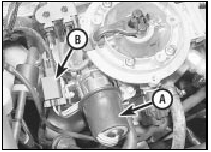Throttle valve control motor (1.6 and 1.8 litre (R6A type) CVH) - removal and refitting
1.6 litre
1 Disconnect the battery negative lead.
2 Remove the air cleaner.
3 Disconnect the wiring connectors from the throttle valve control motor, and the throttle position sensor, pulling on the plugs, not on the wiring (see illustration).

28.3 Throttle valve control motor (A) and wiring plug (B)
4 Remove the three screws securing the motor and the throttle position sensor assembly mounting bracket to the CFI unit, and withdraw the assembly.
5 Remove the three motor securing screws, and withdraw the motor from the bracket.
6 Refitting is a reversal of removal, bearing in mind the following points.
7 Ensure that the throttle position sensor actuating arm locates correctly on the throttle valve spindle, and that the mounting bracket aligns with its locating pegs.
8 On completion, the idle speed should be checked by a Ford dealer at the earliest opportunity.
1.8 litre
9 Disconnect the battery negative lead.
10 Remove the air cleaner assembly.
11 Disconnect the wiring connector from the throttle valve control motor.
12 Remove the three screws securing the motor and the mounting bracket to the CFI unit, and withdraw the assembly.
13 Remove the three motor securing screws, and withdraw the motor from the bracket.
14 Refitting is a reversal of removal, ensuring that the motor is located on the throttle linkage, and that the bracket and locating pegs are aligned.
See also:
Engine mountings - renewal
1 The engine mountings incorporate
hydraulic dampers and must be renewed if
excessive engine movement is evident.
2 Working in the engine compartment,
unscrew the central nuts securing the engine
...
Starter motor - removal and refitting
Removal
1 Disconnect the battery.
2 Working from under the vehicle, disconnect
the main starter motor cable and the two
wires from the starter solenoid (see
illustration).
8.2 Disconnecting th ...
Ford Escort maintenance schedule
The maintenance intervals in this manual are provided with the
assumption that you, not the dealer, will be carrying out the work. These
are the minimum maintenance intervals recommended by the
man ...
